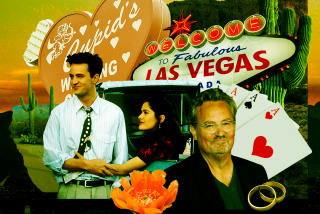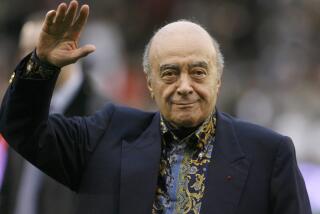To Live--and Die--in Paris as Only Playboys Can
NEW YORK — Now here’s a strange thing. Look back over the newspapers of the last 40 years, and you’ll find that three of the most controversial playboys--Prince Aly Khan, Porfirio Rubirosa, Dodi al Fayed--were killed in car crashes in Paris. These were rich, lucky, good-looking men who collected polo ponies and airplanes and women and traveled in the fast lane until their luck ran out.
Last week, when Fayed and the princess of Wales died, people blamed the paparazzi, the “drunk as a pig” limo driver, the security guard who hadn’t insisted that the other passengers fasten their seat belts, the British royals who weren’t sufficiently cuddly. In the New York Times, columnist William Safire even blamed Dodi.
But maybe the indictments should have included Paris, and its seductions that tend to make one reckless. Paris is for lovers, Paris has the prettiest girls, Paris has chestnuts in blossom and all that champagne. While the English were still boiling everything they ate, the French were joyously destroying their livers with foi gras. The Brits were so law-abiding they’d stand for an hour at a stuck traffic light; the French invented laissez faire.
What playboy wouldn’t choose to go to Paris to play?
But Fayed may have been the last playboy. Because being a playboy is a lost art, as dead as the cool guys that practiced it. A playboy knew how to rumba. A playboy knew how to open a car door for a woman, how to help a woman choose a hat and how to light a woman’s cigarette in the days when everyone smoked. Rubirosa told a friend there were 26 different ways to kiss a woman’s hand, depending on whether she was a woman you wanted to sleep with, or the sister of a woman you wanted to sleep with, or your mother-in-law or the queen of Brataria. He was also said to be a great lover--the giant pepper mills in restaurants were nicknamed “Rubirosas.”
In the days when playboys flourished, most of the great ones knew each other. Rubirosa and Aly Khan, for instance, were friends--though Aly came to grief five years before Rubi did. It was in May of 1960 that Aly, son of the Aga Khan, died of a fractured skull at the Foch Hospital in Paris, after his Lancia sports car smashed into a Simca Aronde. He was coming from the races at Longchamps, a beautiful woman--the model Bettina Graziani--at his side.
Aly, who had once been married to movie star Rita Hayworth (the couple is pictured on Page 1), was catnip to the ladies. Indeed, he had been such a naughty boy in his salad days that he was not permitted to take his father’s place as the spiritual leader of 20 million Ismailian Muslims. When the old Aga Khan died, Aly’s son, Karim, succeeded him. One month away from his 49th birthday, Aly crashed. Ironically, he was then forging a reputation for hard work as Pakistan’s chief U.N. delegate.
Five years later, just a few miles from where Aly Khan had been killed, Dominican-born Porfirio Rubirosa came to grief at the wheel of his Ferrari after he clipped a parked car in the Boulogne Woods, then smashed head-on into a tree. Like Aly, he’d done some government work; one headline announced, “Playboy-Diplomat Rubirosa Killed When Sports Car Crashes in Paris.”
Ah, but Rubi was a playboy for all seasons. His first wife was the daughter of the Dominican dictator Rafael Trujillo; his second was actress Danielle Darrieux (“the most beautiful woman in the world”), and his third was Doris Duke (“the richest woman in the world”). He smoked a cigarette throughout the ceremony that bound him to Duke. Talk about debonair. After Doris, he took Barbara Hutton, the Woolworth heiress, to be his wedded wife, thus achieving, in the words of a society reporter, “the nuptial parlay of the century.”
Rubi was a polo player, an airplane pilot, a seeker of sunken treasure, a lover. He was named as co-respondent in the divorces of golfer Bobby Sweeney and tobacco heir Richard J. Reynolds Jr., he was questioned in the disappearance of opponents of the Trujillo regime, but scandals didn’t faze him. A reporter described him as “a tough guy with beautiful manners . . . swarthy good looks, smooth rhythm on the dance floor, faultless tailoring, an intriguing accent, sex appeal” and added that he was “an adaptable companion.”
(In a kind of aside, we could mention that Rubirosa had a role model who married rich women back in the 1930s. Prince Alexis Mdivani, one of “the marrying Mdivani brothers,” first married Louise Van Alen, a beauty and heiress. After she and Mdivani split, he turned right around and married the young Barbara Hutton. Mdivani was also killed in an auto accident. It happened in Spain, but believe it or not, he was rushing to catch a train to Paris.)
Fayed didn’t have as high a profile as Aly and Rubi--these days, there are too many celebrities. Readers who would once have followed the exploits of playboys now have Madonna and the Kennedys and old rock stars to worry about. If Fayed weren’t wooing the princess of Wales, he might have remained unsung.
Not that he’d ever have had to marry for money--his daddy owned the Paris Ritz, among other things--but his reputation was enhanced by his connection to the much-loved Diana, and that was something he did need. The Washington Post called him “a Hollywood dabbler who lived to get himself in the gossip columns.”
Now his picture, along with Diana’s, is displayed in the window of Harrods, the London store his father owns.
It makes me think of the line in “The Great Gatsby” about a car coming up Gatsby’s driveway to the vacant house that had once rung with music and laughter. “Probably,” the narrator says, “it was some final guest who had been away at the ends of the earth and didn’t know that the party was over.”
The party’s over. The playboys can rest in peace.
More to Read
Sign up for The Wild
We’ll help you find the best places to hike, bike and run, as well as the perfect silent spots for meditation and yoga.
You may occasionally receive promotional content from the Los Angeles Times.






